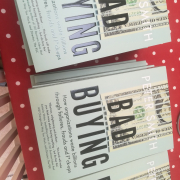Why is the USA Running Out of Baby Formula Milk?
Quite a few stories of procurement and supply chain failure we hear (and quite a few of those included in my Bad Buying book) have at least an element of humour about them. KFC running out of chicken wasn’t very funny for the senior management there, and the customer who phoned the police to complain that he couldn’t get his fried chicken obviously took it seriously. But for most of us, we probably had a chuckle. Government failings are annoying when it is taxpayers’ hard earned money being wasted; but it is rare to see a case of supply chain failure that actually has the potential to cost the lives of babies.
But that is the situation in the USA, where shortages of formula milk for infants is threatening the health or even the survival of very young children. But why is this happening, in one of the wealthiest, most technically advanced nations in the world, where capitalism has over the decades brought a high standard of living (in global terms) and abundant supply of almost everything and anything to its people?
It is a complicated situation, and I’m only giving an overview here. The shortages appear to be driven to a considerable extent by manufacturing plant shut-downs, driven in part by quality issues identified by the US Food and Drug Administration (FDA). FDA (food and drugs administration). As Sky News reported, “Abbott Laboratories was forced to shut its site in Sturgis, Michigan and recall a number of its powdered formula products after four babies who had been given formula developed bacterial infections”. No firm link has been proven but the Michigan factory has been closed for weeks.
Even when the factory re-opens, it will take 8 – 10 weeks to get product back on the shelves, the company says. And once shortages emerge, panic buying inevitably exacerbates the situation, and there may be a bit of a baby boom going on in the US too. The U.S. government also has pretty rigid trade policies, making most formula imported from Europe illegal to buy in the United States. Tariffs act as another deterrent. Maybe that is genuinely for health reasons; or maybe it is at least in part a nice bit of protectionism to suit the manufacturers.
But from a procurement point of view, this market concentration and the inflexibility of government-funded schemes for lower income people have contributed to the problem. Two companies – Abbott and Reckitt Benckiser – dominate the industry with about 80% national market share. Nestlé, which sells under its Gerber brand, controls another 10%.
Part of the reason for these firms’ success is that they are the only makers approved by the US government to provide baby formula through the Special Supplemental Nutrition Program for Women, Infants and Children, known as WIC, which supports low-income families. It appears that most States, who fund these schemes, have negotiated deals with just one provider.
The Guardian reports; “ Nearly half of baby formula in the US is bought under the Wic program, aimed at helping low-income women, infants and children. States give exclusive contract rights for this formula to one company under a bidding process. Abbott provides formula to about half of the babies receiving Wic benefits. When these products disappeared, families were left scrambling to find alternatives”.
This has driven what has proved to be an unhealthy level of market concentration, as it also seems that production is also pretty concentrated within firms in terms of the number of production plants. Now procurement can’t always control market dynamics; but could government as well as buyers (in retail chains for instance) have done more to encourage new suppliers and a more competitive market?
So the old principle of consolidation, aggregation and leverage that procurement has lived by for decades has been driving behaviour here. But once shortages kick-in, recipients of the WIC benefit have been unable to find the approved supplier’s product, leaving them in a desperate state – and an example of the unintended consequences of what must have seemed like a sensible procurement strategy. The U.S. House of Representatives has now passed bills to try and address the shortage. One would waive certain requirements that limit brands and quantities of formula recipients of the special supplemental nutrition for women, infants, and children can purchase, according to CBS News.
Again, supply chain and procurement risk and resilience has not been considered as it should have been here, with cost driving the decisions. We’ve seen over the years so many examples where procurement behaviour has driven dependence on a few suppliers – or even just one (there’s an interesting example featuring VW cars in the book, for instance). It rarely ends well. So next time someone says, “we should rationalise our supply base and dramatically reduce the number of suppliers”, do remember that strategy can have benefits, but also caries risks. Be aware of that and develop the strategy accordingly.
Back to the highly concerning baby milk story. I’m sure more will emerge, and if you want a fuller explanation, I can recommend Kelly Barner’s excellent podcast here, in which she goes into more detail in terms of what has been going on.









